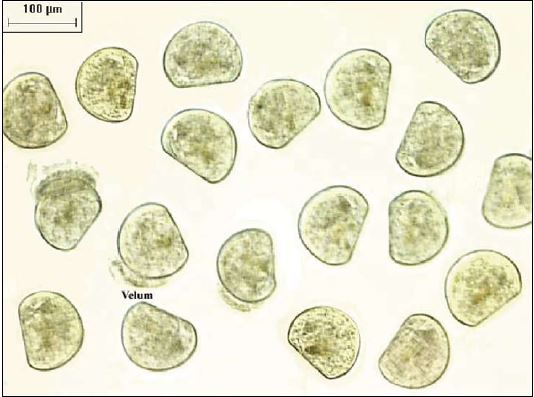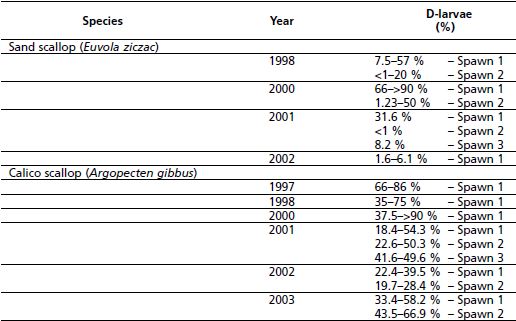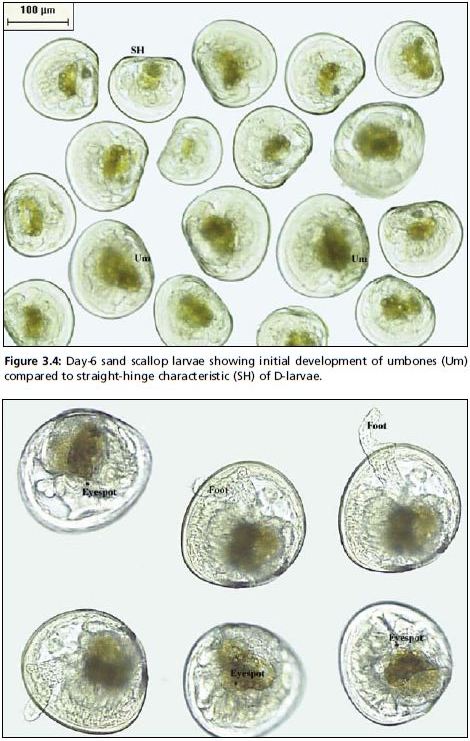3.2 SCIENTIFIC BACKGROUND – EMBRYONIC AND LARVAL DEVELOPMENT
There are many problems which may arise in the reliable hatchery production of bivalve species. Successful hatchery production of larvae and spat is very dependent on the skill and experience of the staff. As mentioned at the beginning of this Chapter, a keen awareness of the importance of hygiene is essential. In general terms, higher mortalities of larvae are often associated with higher temperatures triggering greater bacterial proliferation and infection.
Chapter 1 describes the procedures followed for spawning induction of adults and fertilization of the eggs. In the following section, procedures followed for embryonic development and larval rearing are discussed.
3.2.1 Embryonic development to D-larvae
A generalized life cycle for pectinids is given in Chapter 1 (see Figure 1.7), as well as a brief synopsis of the sequence of events following fertilization, prior to distribution of eggs in culture tanks for both Euvola ziczac and Argopecten gibbus (see Section 1.3.3). In Figure 3.1, the change in shape of the various stages of development from fertilized egg, through D-larvae to pediveliger for sand scallop larvae is shown. Development of E. ziczac and A. gibbus larvae is similar to that seen for other pectinids, which has been described in great detail in the literature (Costello et al. 1973; Culliney, 1974; Paulet, Lucas and Gerard, 1988; Kasyanov, 1991; Cragg and Crisp, 1991). For the purpose of this manual, a brief generalized description of each stage is given in the appropriate sections as a quick reference. However, as the rate at which larvae develop varies with species, the short section below gives that observed for the sand and calico scallop in Bermuda.
Embryos are left undisturbed for the first 48 hours. During this time period, repeated cleavages lead to formation of the spherical blastula; timing varies among species and was not determined for either the zigzag or calico scallop, but was determined for

Figure 3.1: Developmental changes of sand scallop larvae to metamorphosis.
a related species, Aequipecten irradians concentricus, to be of five hours and fifteen minutes (Sastry, 1965). The rotating ciliated gastrula appears thereafter (nine hours after insemination for A. concentricus). Changes from a ciliated gastrula to the top shaped trochophore are gradual (see Life cycle – section 1.2.3).
First observations at the BBSR hatchery are made 24 hours after distribution of embryos in culture tanks, when samples are taken by skimming the surface of the water with a 20 µm sieve and examined under a compound microscope. At this time, trochophore larvae and often, early veliger larvae are observed for both E. ziczac and A. gibbus cultures. Pectinid trochophore larvae are characteristic in that the apical end is rounded and surmounted with a tuft of long cilia; the other end of the larva is tapered with indentations on either side of the larva. During this stage, there is little calcification, and shell secretion is initiated at the end of the trochophore stage. Due to this soft-body characteristic they are very fragile; for this reason, 24 hours larval cultures are left undisturbed, as collection on sieves would be damaging.
Figure 3.2 shows veliger larvae of E. ziczac, characterised by their velum, a distinct organ emerging during the transition from trochophore to veliger. As these early 24 hours veliger larvae exhibit an active swimming behaviour both for A. gibbus and E. ziczac, addition of formaldehyde is required for a clear photograph; this also causes the velum to retract, for this reason, only a few of the larvae seen have been caught with the velum extended. Veliger larvae remain uniformly suspended in the water column. To ensure complete development for a maximum number of embryos, a 48-hour time period is allocated prior to the first collection of larvae. This allows time for the developing larvae to take on the D-shaped outline characteristic of the prodissoconch-I shell. Complete development to the D-larval stage (or straight-hinge stage) thus occurs 48 hours after fertilization (Figure 3.3). In contrast to the 24-hour veligers, D-larvae of the sand and calico scallop remain for the most part still and swim occasionally upon being disturbed. Costello et al. (1973) report a similar developmental rate for A. gibbus D-larvae.

Figure 3.2: One-day old E. ziczac veligers showing extended velum.

Figure 3.3: Straight-hinge or D-larvae stage of E. ziczac.
3.2.1.1 Fertilized eggs: characteristics and developmental requirements
Egg diameter for pectinids generally range from 57–79 µm diameter (Cragg and Crisp, 1991). Within a species, egg size, may vary slightly among batches; according to Kraeuter, Castagna and Dessel (1982), this size difference, although slight, may reflect the amount of reserves stored in the egg and impact subsequent development and growth. These authors suggest eliminating smaller size eggs and concentrate on better care of larger egg sizes that are more likely to survive. Reduced survival of certain batches in hatcheries, especially towards the end of the hatchery season (as seen in Chapter 1), is often related to higher temperatures and bacterial contamination; however, a significant portion of these losses may be due to use of smaller eggs with reduced stored reserves. Mean egg size for E. ziczac is found to be 64.8±6.8 µm (n= 50), and for A. gibbus 55.9±3.2 µm (n= 50). Size measured for A. gibbus in Bermuda is slightly lower than recorded by Costello et al. (1973) – 60 µm diameter – for the same species. This difference may be attributed to environmental differences reflected in stored reserves.
Differences among batches of calico scallop eggs are observed at the Bermuda hatchery, namely with respect to buoyancy. Some batches are neutrally buoyant and remain suspended throughout the water column; however, other batches are negatively buoyant and sink to the bottom of the culture tank. This difference in buoyancy among batches has never been associated with a change in developmental success of the embryos or of the larvae thereafter at the Bermuda hatchery. This weight difference may be explained in part by the differences in amount of reserves as reported by Kraeuter, Castagna and Dessel (1982). Negative buoyancy has also been reported for Patinopecten yessoensis resulting in a monolayer of eggs at the bottom of the culture tanks (Bourne, Hodgson and Whyte, 1989). For this reason, it is best not to aerate, as embryos will collect in windrows at the edge of the tank because of water circulation. On the other hand, in E. ziczac, fertilized eggs are neutrally buoyant remaining suspended throughout the water column.
All fertilized eggs are pooled at the hatchery in Bermuda without any size screening, but with some subjective selection related to shape, development and uniformity. For example, those eggs released as clumps, or potentially self-fertilized, were classified as “bad”. An attempt is made at rearing “good” and “bad” in separate culture vessels. It is uncertain whether this arbitrary selection enhances embryonic development, and batches of “bad” eggs lead at times to surprisingly good D-larval cultures. The density at which eggs are distributed varies with species. Calico scallops have been reportedly reared at as high a density as 25 eggs.ml-1 (Costello et al. 1973). On the other hand, lower densities (10 eggs.ml-1) are used for the queen scallop (Neima and Kenchington, 1997). In Bermuda, it has been observed that a higher survival to Day 2 larvae is obtained for the sand scallop for batches with an initial egg density less than or equal to 10 eggs.ml-1.
Egg size and rearing density used are thus two factors, which may affect development success to the D-larva stage. Sperm concentration has also been shown to be a major factor in the production of normal bivalve larvae in the laboratory (Loosanoff and Davis, 1963; Gruffydd and Beaumont, 1970). A ratio of 1:6 (egg:sperm) is a standard objective; in the hatchery 1–2 ml of sperm solution per 1 litre of egg solution is found sufficient for successful fertilization. Beaumont and Budd (1983) have shown that there are significant genetic effects during fertilization and the early larval life in Pecten maximus. In their study, the origin of both eggs and sperms independently affected the number of eggs, which produced larvae. For this reason, it is routine procedure to fertilize each female with several sperm solutions, in hopes of enhancing developmental success to D-larval stage. An additional consideration needs to be taken for hermaphroditic species, such as zigzag and calico scallops, to minimize abnormal development. In these species, the probability of self-fertilization during laboratory spawning is enhanced, and self-fertilization has been also associated with detrimental effects in development. Beaumont and Budd (1983) found a severe reduction in growth rate of P. maximus veligers in all self-fertilized cultures. Sastry (1965) found similar unsatisfactory results in selfed eggs of A. irradians concentricus. It has always been a preventive measure during hatchery procedures in Bermuda to avoid self-fertilization in the laboratory and ensure cross-fertilization using several males.
As seen in Table 3.1, variations in percentage D-larvae obtained among and within batches are large. Variations among batches may be a reflection of one or several of the factors mentioned above, namely egg size (or stored reserves) and density. Variations within batches may also be a reflection of the arbitrary selection conducted during distribution of eggs into culture tanks. Other factors, such as variations in salinity (Gruffydd and Beaumont, 1970), and in dissolved organic matter (Crisp, 1982) have also
Table 3.1: Yields of Day-2 larvae obtained for several hatchery seasons following controlled fertilization of E. ziczac and A. gibbus in the hatchery. Ranges shown indicate yields obtained for all larval tanks in one spawning. Single numbers indicate mean yield for one spawning.

been associated with variations in yield and normality of P. maximus D-larvae. These are most likely not a consideration in Bermuda and have not been investigated.
3.2.2 Larval development
The characteristic “D” shape of early larvae (Figure 3.3) has two valves, a complete digestive system and a velum. The velum is ciliated along its outer margin and enables the larva to swim, enabling it to maintain itself in the water column. As it is swimming, the velum collects unicellular phytoplankton upon which the larva feeds. From hereon, larvae are fed daily a food ration consisting of live algal species, cultured on-site (see Chapter 2).
3.2.2.1 Veliger larvae
As mentioned in the description of embryonic development, the shell appears in the early stages of development (24 hours after fertilization). The veliger shell (prodissoconch-I) is produced by the secretory cells of the shell gland. Kasyanov (1991) gives detailed schematics of the development of the Japanese scallop, Mizuhopecten yessoensis. The larval body of the veliger is covered by a semi-transparent shell through which the internal organs are discernible. The digestive system of bivalve larvae consists of the ectodermal fore-gut, the endodermal mid-gut and the ectodermal hind-gut. Food is captured and transported to the mouth opening by ciliary bands on the velum. This function of the velum is as important as the locomotory function. The veliger larva swims actively with the velum extended. The mouth opening situated at the edge of the lower part of the velum leads to the oesophagus, which in turn leads to the stomach. The digestive gland is large and is formed as two stomach pouches. Accumulations of granules of nutritive substances are seen in the cells of the gland. The gland contains digestive enzymes and also opens into the stomach. The stomach leads posteriorly to a short intestine opening to the exterior as anus. The anterior adductor muscle is located dorsal to the anterior attachment of the velum. The respiratory and circulatory systems are absent in the veliger of bivalve mollusc. The influx of oxygen and the excretion of carbonic acid occur by diffusion. The nervous system is considerably developed and is represented by the cerebral ganglion and two pedal ganglia. The main sense organ in the veliger larva is the apical plate of the velum. Straight-hinge larvae vary in length among pectinid species; for example, 78 µm for A. irradians concentricus, and 90 µm for Placopecten magellanicus (Sastry, 1965; Couturier, Dabinett and Lanteigne, 1996). In Bermuda, shell length for D-larvae of A. gibbus ranges from 92.7±4.7 µm to 101.0±4.22 µm, and for E. ziczac from 93.1±8.3 µm to 110.4±5.0 µm.
3.2.2.2 Pediveliger larvae
The shape of the D-larvae gradually changes with age. As veligers develop, a slight reduction in the hinge-length with the extension of umbones over the hinge region is seen. Costello et al. (1973) report the appearance of the umbo at 140 µm for calico scallops; in Bermuda, this appearance is seen as early as Day-6 old scallops with a mean size of 115 µm shell length (Figure 3.4). The degree of umbo development varies among species, and is for example more conspicuous in the sand scallop than in the calico scallop. Shell growth in the anterior-posterior direction also takes place. The internal organs, such as the stomach, develop. The foot begins to develop as a small projection ventral to the mouth; it is recognizable especially when the larva has retracted into the shell. In 9 Day old veligers, an “eyespot” (darkly colored spot) becomes conspicuous, especially noticeable in E. ziczac (Figure 3.5). This appearance of the eye spots with the statocysts is characteristic of pediveligers. The velum reduces gradually and the foot continues to develop; swimming activity also decreases. By the twelfth day the well grown umbones almost mask the hinge line of the early veliger shell. For this reason, the pediveliger shell is triangular, egg-shape.
Bower and Meyer (1990) give very detailed drawings for Patinopecten yessoensis. Pediveliger larvae reach the maximum size and develop a functional foot. The foot is a multi-functional organ; it mainly serves to search for a substrate for settlement and attach the larva to the substrate by byssal threads. Swimming larvae can extend the

Figure 3.4: Day-6 sand scallop larvae showing initial development of umbones (Um) compared to straight-hinge characteristic (SH) of D-larvae.
Figure 3.5: Day-11 pediveligers of E. ziczac showing eyespot and a well-developed foot in and out of the shell.
foot which, when brought into contact with the substrate, facilitates crawling over the substrate. The result of crawling can be that: 1) the larva attaches itself to the substrate, or 2) the larva retracts the foot, leaves this substrate and resumes swimming in search of a more adequate substrate. At this time, larvae are more often collected from the bottom water, rather than throughout the water column as in the earlier stages. The most important changes in the larvae take place between the twelfth and fourteenth days of development. The umbones are fully grown, overhang the straight-hinge of the early veliger shell, and are directed posteriorly. The shell has a curved appearance at the hinge attachment. This prodissoconch-II stage is identified as such to distinguish it from the early veliger and pediveliger stages. The anatomy of the prodissoconch shows important differences from the earlier stages. The mouth is located in an anterior and dorsal position, bringing it to the adult position. The mantle is well developed. The foot is enlarged and is a wedge-shaped organ with cilia at the free or distal end. The foot has a cleft in the middle region and the byssal gland is located there. A pair of statocysts is present. The gills are developed as a pair of ciliated folds ventral to the foot. With development of new organs and the loss of some larval organs, metamorphosis is completed. The average size of the prodissoconch-II shell for Day-14 calico scallops is of 200 µm shell length, and for zigzag scallops of 215 µm.
Prodissoconch-II larva attaches to the substratum with the byssal threads; in the hatchery, surfaces are provided during this settlement phase. Thereafter, rapid changes in shell morphology and growth of internal organs take place resulting in the adult scallop form. Post-larval development is discussed in Chapter 4.